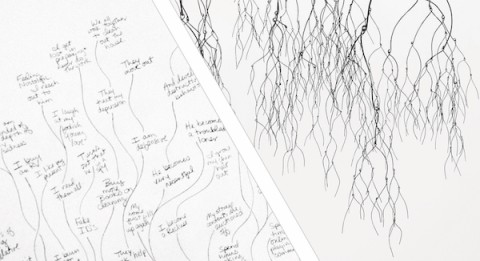Known for her drawings, sculpture, and architectural interventions, Beth Campbell creates works that challenge the notion of a physical world beyond our perception. Drawing upon philosophy, phenomenology and psychology, Campbell choreographs spaces, crafts uncanny objects, and maps thought.
Her diagrammatic drawing series, Potential Future Drawing— from which Landmarks’ commission is derived—embodies Campbell’s interest in giving physical shape to streams of consciousness; each drawing branches out from a single occurrence in her everyday life into a host of outcomes ranging from fantastic to abysmal.
Campbell’s mobiles manifest a similar interest in parallel realities. Conceived as ‘drawings in space,’ their abstract forms of bent steel and wire evoke Freud’s neurological diagrams, trees, and circulatory systems, while also serving as speculative visualizations of possibility.
In this excerpt from a 2013 Mutual Art interview with curator Sarah Murkett, later published in The Huffington Post, Campbell describes the evolution of her work:
Some of your earlier works like the drawings in your series My Potential Future Based on Present Circumstances and the video installation, Same as Me, have diaristic elements. How much of your work is based on personal experience?
In the very beginning in school, all of it, but that was before my real art work began. I entered graduate school as a painting major, but one month into the program I stopped and dove into making installation. I had no sculptural background or material knowledge in terms of how to build things. It was all very new to me too in terms of the kind of content that materials could provide. In painting you don’t really have that as an issue. When I started to find my voice, the work came from my person in a way, but not like in an autobiographical story. At the time I was really interested in Charles Ray……still am, he’s a great artist, and I met with him in grad school and I worked with him when I was at Skowhegan…. so the way in which he used himself, but his work wasn’t literally about himself. He had made figurative work, and the work started through him in a way. So my work operated more like that. The piece, Everything I Own, which in a way is about using the world around you to make an artwork – letting everything in. And so I brought everything that I owned into my studio and made a canyon from it. It started with me. And there was a piece where I explored making by un-making through unraveling one of my outfits. And also a drawing calledWeb Drawing of Me, which later led to of the Potential Future series and started with the word ‘me’ in the center. Again it seems very personal but it was really trying to figure out as an individual the various roles we play, and so it was something that could be applied to everybody. It was using me as a way to make a sculpture or talk about what it is to be alive, or something philosophical, or social and psychological. And then the series My Potential Future Based on Present Circumstances started when I was in New York. And it is interesting because early on many people thought of these drawings as being very truthful but they are really fictional. The first line is true like, “I met Peter” or “I worked at Bark Frameworks” or “I bought a vacuum” – just different little morsels of your everyday – but everything else that is written is really a fiction, or rather many fictions. But I would add that I could hide sentiments within it.
Even though they are not truthful because they’re about potentials, they do feel like they are revealing something about you.
It is true. They are revealing. Although, sometimes when people would summarize them in reviews they would pick a quote from the drawing and say that it happened. There were parts of the future in which I died from drug overdoses or that I had six kids, so that clearly didn’t happen. So those were fictions, but I agree completely that certain personal sentiments, or desires, or fears, were hidden within them. I feel like the density of them allowed me to say really anything because it was crowded out by all these other possibilities. But overall, I feel the work speaks of an anxiety produced by our culture.
Don’t miss an opportunity to hear directly from Campbell at Landmarks’ Q & A with the artist and philosopher Timothy Morton on April 11.
*Content for this blog was drawn from the artist’s website, and from the above refenced interview for Mutual Art.

Detail of Spontaneous future(s), Possible past, 2019; There's no such thing as a good decision (lament), 2009
